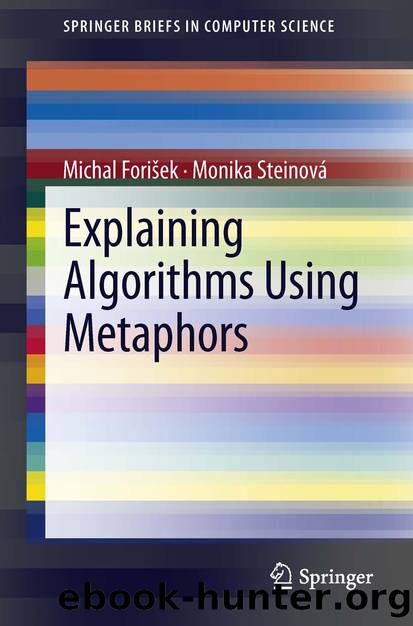Explaining Algorithms Using Metaphors by Michal Forišek & Monika Steinová

Author:Michal Forišek & Monika Steinová
Language: eng
Format: epub
Publisher: Springer London, London
3.3 Winding Number
3.3.1 Overview
In this section and the next one we will be dealing with polygons and polylines.
A closed polyline is a polyline that starts and ends in the same point. Sometimes, we will assign direction to a polyline. Then, a closed polyline can be seen as a sequence of directed line segments such that each segment starts where the previous one ends, and the last segment ends where the first one started.
A polygon is a closed polyline that never touches or intersects itself. The word “polygon” is also used for the entire area enclosed inside such a polyline, including the boundary. (The intended meaning will always be clear from the context.)
We will consider another traditional problem in two-dimensional computational geometry: testing whether a given point is contained in a given polygon.
Point in polygon inclusion test Instance: A point and a polygon (in a two-dimensional plane). Problem: Check whether the point lies inside, on the boundary, or outside of the polygon.
Checking whether a point lies on the boundary of a polygon can easily be done in linear time: for each side, check whether it contains the point. Below, we shall assume that this test has already been made and that the outcome was negative. That is, the given point is either strictly inside, or strictly outside the polygon.
The canonical solution that distinguishes between those two cases is the “ray casting” algorithm: Pick any ray (i.e., a half-line) starting at the given point. Count the number of times it crosses the polygon boundary. If this number is odd, the point is inside, otherwise it is outside the polygon.
While the idea behind this solution is simple and its correctness obvious, there is a reason we do not really like it: the implementation has too many special cases. Note that we are not counting the number of intersections between the ray and the polygon. In some cases, such an intersection counts as crossing the boundary, in others it does not, and in yet other cases there can even be an infinite number of intersections. Some of the tricky cases are shown in Fig. 3.15. In fact, even the original publication of the algorithm [14] contains a bug [9].
Fig. 3.15Some of the special cases in the ray casting algorithm: We are checking whether lies inside the polygon. At the ray crosses an edge to get out of the polygon. At the ray hits a vertex and reenters the polygon. At the ray hits another vertex, but this time it stays inside the polygon. Between and the ray even goes along polygon boundary, before finally leaving the polygon
Download
This site does not store any files on its server. We only index and link to content provided by other sites. Please contact the content providers to delete copyright contents if any and email us, we'll remove relevant links or contents immediately.
Navigation and Map Reading by K Andrew(4854)
Spare by Prince Harry The Duke of Sussex(4744)
Tuesdays with Morrie by Mitch Albom(4352)
Cracking the GRE Premium Edition with 6 Practice Tests, 2015 (Graduate School Test Preparation) by Princeton Review(3993)
What It Really Takes to Get Into Ivy League and Other Highly Selective Colleges by Hughes Chuck(3517)
Never by Ken Follett(3477)
Goodbye Paradise(3410)
Machine Learning at Scale with H2O by Gregory Keys | David Whiting(3399)
Harry Potter and the Prisoner of Azkaban (Book 3) by J. K. Rowling(3078)
Pledged by Alexandra Robbins(3028)
Kick Ass in College: Highest Rated "How to Study in College" Book | 77 Ninja Study Skills Tips and Career Strategies | Motivational for College Students: A Guerrilla Guide to College Success by Fox Gunnar(2975)
Fairy Tale by Stephen King(2832)
A Dictionary of Sociology by Unknown(2826)
Sapiens and Homo Deus by Yuval Noah Harari(2811)
The Social Psychology of Inequality by Unknown(2718)
Graduate Admissions Essays, Fourth Edition: Write Your Way into the Graduate School of Your Choice (Graduate Admissions Essays: Write Your Way Into the) by Asher Donald(2706)
Reminders of Him: A Novel by Colleen Hoover(2671)
Get into Any College by Tanabe Gen Tanabe Kelly(2612)
Zero to Make by David Lang(2599)
